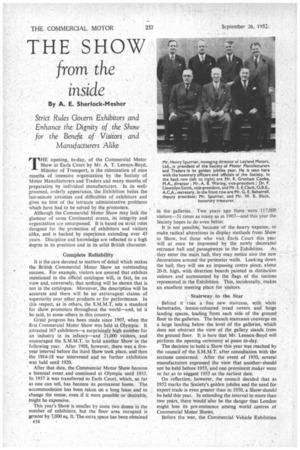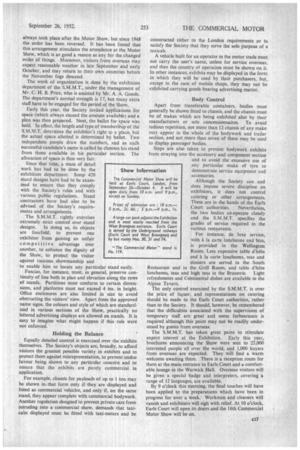THE SHOW from the
Page 82

Page 83

If you've noticed an error in this article please click here to report it so we can fix it.
inside
By A. E. Sherlock-Mesher Strict Rules Govern Exhibitors and Enhance the Dignity of the Show . for the Benefit of Visitors . and Manufacturers Alike THE opening, to-day, of the Commercial Motor Show at Earls Court by Mr. A. T. Lennox-Boyd, Minister of Transport, is the culmination of nine months of intensive organization by the Society of Motor Manufacturers and Traders and many months of preparation by individual manufacturers. In its wellgroomed, orderly appearance, the Exhibition belies the last-minute anxieties and difficulties of exhibitors and gives no hint of the intricate administrative problems
which have had to be solved by the promoters. ,
Although the Commercial Motor Show may lack the glamour of some Continental events, its integrity and organization are unsurpassed. It is based on strict rules designed for the protection of exhibitors and visitors alike, and is backed by expeirience extending over 45 years. Discipline and knowledge are reflected to a high degree in its precision and in its solid British character.
• Complete Reliability It is the care devoted to matters of detail which makes the British Commercial Motor Show an outstanding success. For example, visitors are assured that exhibits mentioned in the official catalogue will, in fact, be on view and, conversely, that nothing will be shown that is not in the catalogue. Moreover, the description will be accurate and there will be no extravagant claims of
, superiority over other products or for performance. In this respect, as in others, the S.M,M.T. sets a standard for show promoters throughout the world—and, let it be said, to some others in this country.
Great progress has been made since 1907, when the first Commercial Motor Show was held at Olympia. It attracted 167 exhibitors—a surprisingly high number for an industry in its infancy—and 21,000 visitors, and encouraged the S.M.M,T. to hold another Show in the following year. After 1908, however, there was a fiveyear interval before the third Show took place, and then the 1914-18 war intervened and no further exhibition was held until 1920.
After that date, the Commercial Motor Show became a biennial event and continued at Olympia until 1935. In 1937 it was transferred to Earls Court, which, so far as one can tell, has become its permanent home. The accommodation has been taken on a long lease and to change the venue, even if it were possible or desirable, might be expensive.
This year's Show is smaller by some two dozen in the number of exhibitors, hut the floor area occupied is greater by 7,000 sq. ft. The extra space has been obtained c16
in the galleries. Two years ago there were 117,000 visitors-51 times as many as in 1907—and this year the
Society hopes to do even better.
It is not possible, because of the heavy expense,to make radical alterations in display methods from Show
to Show, but those who visit. Earls Court this year will at once be impressed by the newly decorated
entrance hall and passageways to the Exhibition. As they enter the main hall, they may notice also the new decorations around the perimeter walls. Looking down the hall, they will see an imposing centre piece, about 20-ft. high, with direction boards painted in distinctive colours and surmounted by the flags of the nations represented in the Exhibition. This, incidentally, makes an excellent meeting place for visitors.
Stairway to the Star Behind it rises a fine new staircase, w,ith white balustrades, lemon-coloured tread covers and beige landing spaces, leading from each side of the ground floor to the galleries. The branch staircases converge on a large landing below the level of the galleries, which does not obstruct the view of the gallery stands from the ground floor. It is here that Mr. Lennox-Boyd will perform the opening ceremony at noon to-day.
The decision to hold a Show this year was reached by the council of the S.M.M.T. after consultation with the sections concerned. After the event of 1950, several manufacturers expressed the view that another• should not be held before 1953, and one prominent maker went so far as to suggest 1955 as the earliest date.
On reflection, however, the council decided that as 1952 marks the Society's golden jubilee and the need for export trade is even greater than in 1950, a Show should be held this year. In extending the interval to more than two years. there would also be the danger that London might lose its pre-eminence among world centres of Commercial Motor Shows.
Before the war, the Commercial Vehicle Exhibition
always took place after the Motor Show, but since 1948 the order has been reversed. It has been found that this arrangement stimulates the attendance at the Motor Show, which is as good a reason as any for the changed order of things. Moreover, visitors from overseas may expect reasonable weather in late September and early October, and may return to their own countries before the November fogs descend.
The work of organization is done by the exhibition department of the S.M.M.T., under the management of Mr. C. H. B. Price, who is assisted by Mr. A_ A. Goode. The department's normal strength is 17, but many extra staff have to be engaged for the period of the Show.
Early this year, the Society invited applications for space (which always exceed the amount available) and a plan was then prepared. Next, the ballot for space was held. In effect, the length and type of memberihip of the S.M.M.T. determine the exhibitor's right to a place, but the actual space allotted is determined by ballot. Two independent people draw the numbers, and as each successful candidate's name is called he chooses his stand from those available in his particular section. The allocation of space is thus very fair.
Since that time, a mass of detail work has had to be done by the exhibition department. Some 420 stand designs have had to be examined to ensure that they comply with the Society's rules and with various public regulations. Stand contractors have had also to be advised of the Society's requirements and arrangements.
The S.M.M.T. rightly exercises extremely strict control over stand designs. In doing so, its objects are fourfold; to prevent one exhibitor from gaining an unfair competitive advantage over another, to enhance the dignity of the Show, to protect the visitor against raucous showmanship and to enable him to locate any particular stand easily.
Fascias, for instance, must, in general, preserve continuity of line both in plan and elevation along the rows of stands. Partitions must conform to certain dimensions, and platforms must not exceed 4 ins, in height. Office enclosures are also limited in size to avoid obstructing the visitors' view. Apart from the approved name signs, the colours and style of which are standardized in various sections of the Show, practically no lettered advertising displays are allowed on stands. It is easy to imagine what might happen if this rule not enforced. were
Holding the Balance
Equally detailed control is exercised over the exhibits themselves. The Society's objects are, broadly, to afford visitors the greatest possible variety in exhibits and to protect them against misrepresentation, to prevent undue favour being shown to any particular concern and to ensure that the exhibits are purely commercial in application.
For example, chassis for payloads of up to 1 ton may be shown in. that form only if they are displayed and listed as commercial vehicles, and only if, on the same stand, they appear complete with commercial bodywork. Another regulation designed to prevent private cars from intruding into a commercial show, demands that taxicabs displayed must be fitted with taxi-meters and be constructed either to the London requirements or to satisfy the Society that they serve the sole purpose of a taxicab.
A vehicle built for an operator in the motor trade must not carry the user's name, unless for service overseas, and then the country of operation must be shown on it. In other instances, exhibits may be displayed in the form in which they will be used by their purchasers, but, except in the case of mobile shops, they may not be exhibited carrying goods bearing advertising matter.
Body Control
Apart from transferable containers, bodies must generally be shown fitted to chassis, and the chassis must be of makes which are being exhibited alsd by their manufacturers or sole concessionnaires. To avoid tedious repetition, not more than 12 chassis of any make may appear in the whole of the bodywork and trailer section, and not more than seven of these may be used to display passenger bodies.
Steps are also taken to prevent bodywork exhibits from straying into the accessory and component section and to avoid the excessive use of any particular make of tyre to demonstrate service equipment and accessories.
Although the Society can and does impose severe discipline on exhibitors, it does not control catering or other arrangements. These are in the hands of the Earls Court authorities. Nevertheless, the two bodies co-operate closely and the S.M.M.T. specifies the grades of service required in the various restaurants.
For instance, de luxe service,
with a la carte luncheons and teas, is provided in the Wellington Room. Less expensive table d'hôte and a la carte luncheons, teas and dinners are served in the South Restaurant and in the Grill Room, and table d'hôte luncheons, teas and high teas in the Brasserie. Light refreshments and Continental dishes are available in the Alpine Tavern.
The only control exercised by the S.M.M.T. is over the price of liquor, and representations on catering should be made to the Earls Court authorities, rather than to the Society. It should, however, be remembered that the difficulties associated with the supervision of temporary staff are great and some forbearance is required although this point may not be readily understood by guests from overseas.
The S.M.M.T. has taken great pains to stimulate export interest at the Exhibition. Early this year, brochures announcing the Show were sent to 25,000 interested people all over the world, and 1,000 buyers from overseas are expected. They will find a warm welcome awaiting them. There is a reception room for them at the main entrance to Earls Court and a comfortable lounge in the Warwick Hall. Overseas visitors will be given a special badge and interpreters, covering a range of 12 languages, are available. By 9 o'clock this morning, the final touches will have been applied to the preparations which have been in progress for over a week. Workmen and cleaners will vanish and exhibitors will sigh with relief. At 10 o'clock, Earls Court will open its doors and the 16th Commercial Motor Show will be on.




































































































































































































































































































